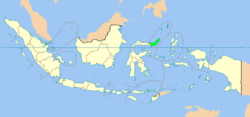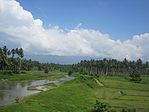North Celebes
|
North Sulawesi Sulawesi Utara |
|||||||||
|---|---|---|---|---|---|---|---|---|---|
| Province | |||||||||
Clockwise, from top left : The view of Mount Tumpa from Malalayang Beach, Lake Tondano, Teluk Buyat Beach, Bentenan Beach, A landscape in North Sulawesi, Bunaken and Manado Tua, Mount Lokon
|
|||||||||
|
|||||||||
| Motto: Si Tou Timou Tumou Tou (Minahasan) (Human purpose in life is to nurture and educate others) |
|||||||||
 Location of North Sulawesi in Indonesia |
|||||||||
| Coordinates: 1°15′N 124°50′E / 1.250°N 124.833°ECoordinates: 1°15′N 124°50′E / 1.250°N 124.833°E | |||||||||
| Country |
|
||||||||
| Established | 14 August 1959 | ||||||||
| Capital |
|
||||||||
| Government | |||||||||
| • Body | North Sulawesi Regional Government | ||||||||
| • Governor | Olly Dondokambey (PDI-P) | ||||||||
| • Vice Governor | Steven Kandouw | ||||||||
| Area | |||||||||
| • Total | 13,851.64 km2 (5,348.15 sq mi) | ||||||||
| Area rank | 27th | ||||||||
| Highest elevation | 1,995 m (6,545 ft) | ||||||||
| Population (2014) | |||||||||
| • Total | 4,353,540 | ||||||||
| • Density | 310/km2 (810/sq mi) | ||||||||
| Demographics | |||||||||
| • Ethnic groups | Minahasan, Mongondow, Sangirese, Talaud, Gorontaloan, Bugis, Javanese | ||||||||
| • Religion | Protestantism (63.6%), Islam (30.9%), Roman Catholicism (4.4%), Hinduism (0.58%), Buddhism (0.14%), Confucianism (0.02%) | ||||||||
| • Languages | Indonesian (official), Manado Malay (lingua franca), English | ||||||||
| Time zone | Indonesia Central Time (UTC+8) | ||||||||
| Postcodes | 90xxx, 91xxx, 92xxx | ||||||||
| Area codes | (62)4xx | ||||||||
| ISO 3166 code | ID-SA | ||||||||
| Vehicle registration | DB, DL (Sangihe & Talaud Islands) | ||||||||
| HDI |
|
||||||||
| HDI rank | 7th (2015) | ||||||||
| Largest city by area | Bitung - 302.89 square kilometres (116.95 sq mi) | ||||||||
| Largest city by population | Manado - (675,411 - 2010) | ||||||||
| Largest regency by area | Bolaang Mongondow Regency - 2,871.65 square kilometres (1,108.75 sq mi) | ||||||||
| Largest regency by population | Minahasa Regency - (1,710,384 - 2010) | ||||||||
| Website | Government official site | ||||||||
North Sulawesi (Indonesian: Sulawesi Utara) is a province of Indonesia. It is located on the northern peninsula of the island of Sulawesi, on the Minahasa Peninsula lies south of Philippines and southeast of Malaysia. The province's capital and largest city is Manado, and its population was 4,135,526 according to the 2010 census; the latest official estimate (for January 2014) is 4,353,540.
The Dinoyo Inscription which was found near the town Malang is the oldest written sources in East Java, that is in 760. In the year 929, Mpu Sindok, the ruler of Mataram, moved the center of Mataram from Central Java to East Java, as well as establishing the Isyana dynasty which later evolved into Kingdom of Medang and as a successor is Kahuripan, Janggala and the Kingdom of Kediri. In the era of Majapahit under King Hayam Wuruk, its territory up to Malacca, and The Philippines. The earliest evidence of the entry of Islam to East Java is the tomb headstone in Gresik many 1102, as well as a number of Islam tombs at the tomb complex of Majapahit. In addition, also found the appearance of the Jedong temple in the Wagir Region , East Java, which is believed to be older than the Dinoyo inscription , which is about 6th century AD.
Portugal is the firstwestern nation who arrived in North Sulawesi, the Portuguese ship docked on the Manado Island during the reign of the Kingdom of Manado in 1521. Spanish ships docked in the island of Talaud and Siau and continues to Ternate. The Portuguese built a fort at Amurang. The Spanish built forts in, and the Minahassa Peninsula started being colonized by Spain. Resistance against the Spanish colonization peaked in 1660-1664. Ships from the Netherlands landed in Manado in 1660 in helping the Minahasa Confederation to fight against Spain. After defeating the Spain, the Minahasa Confederation entered into an agreement with the Dutch East India Company (VOC). Trade cooperation agreement This then makes VOC monopolize trade, which gradually began to impose its will, eventually leading to a resistance in the 1700's in Ratahan culminating to the Minahasa-Dutch War in 1809 to 1811 in Tondano.
...
Wikipedia








